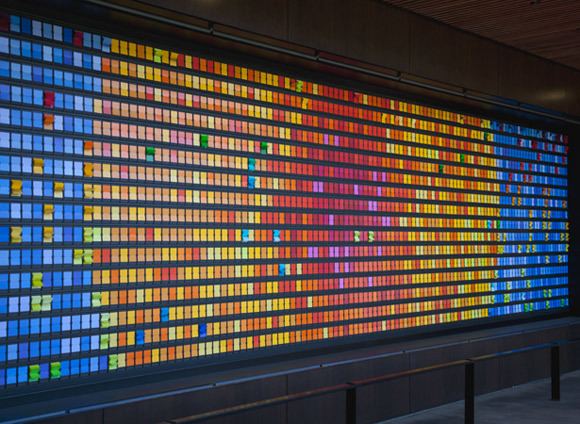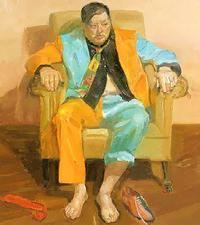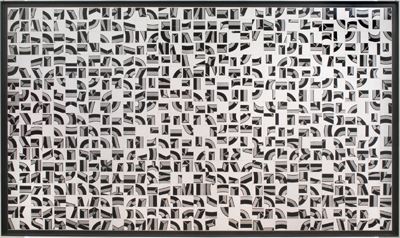Nationality American Name Peter Wegner | Role Artist Education Yale University | |
 | ||
Born 1963 (age 52–53) Sioux Falls, South Dakota, U.S. Known for Paintings, photographs, collages, prints, artist’s books, and large-scale installations Books Buildings Made of Sky | ||
Nix nada nameless peter wegner at tedxeast
Peter Wegner (born 1963) is an American artist whose works consist of paintings, photographs, collages, prints, artist's books, and large-scale installations.
Contents
- Nix nada nameless peter wegner at tedxeast
- Art afterhours richard glover with artist peter wegner and richard morecroft
- Background
- Themes
- Key Works
- Stanford University Commission
- Later Works
- Collections
- Permanent Installations
- Lectures
- Artists Books Monographs
- Exhibitions Projects
- Press
- References

Art afterhours richard glover with artist peter wegner and richard morecroft
Background

Born in Sioux Falls, South Dakota, Peter Wegner earned his BA at Yale University. He works in multiple media, ranging from paintings and photography to large-scale installations and wall works. His pieces are included in major public and private collections worldwide. He currently lives and works in Berkeley, California.
Themes

Critics and scholars have identified at least four major themes in Wegner’s work. The first is the idea of systems and their hidden inadequacies. As architectural scholar Noah Chasin wrote in a 2007 essay, “Systems often make appearances in Wegner’s work to suggest the potential for order, yet the artist continually exposes them as means of introducing disorder… [H]e systematically questions their foundations from within so that the very integrity of each system’s signifying capacity is compromised….”

Wegner himself embraces this idea, even when it comes to classifying the media in which he operates. His official bio states that “[h]e often works between conventional categories, creating sculptural paintings, painterly installations, and architectural photographs.” However, Chasin advises viewers to see this aspect of the artist’s approach as a constructive rather than a destructive one: “We should not conclude that Wegner’s subversion eliminates meaning but instead that it draws our attention to the way that meaning is created and naturalized.”

Another core theme in Wegner’s work is color. Professor, author, and critic Eve Meltzer noted in a 2002 review that “color may be the… center” of his entire practice. Poet and essayist John Koethe also described Wegner as “obsessed with color.” The artist first began deconstructing the subject in the late 1990s with his “Remarks On Color” series, which used commercial paint chip samples as their starting point.

Yet analysts (and Wegner himself) have pointed out that, for the artist, color is often a path to other topics. His color-based “D65” series, begun in 2014, takes its title from “the standard scientific shorthand for the color of daylight, roughly 6500 degrees Kelvin” and is “inspired by sunlight in California,” according to Wegner. More than a decade earlier, Meltzer linked his use of color with market mechanisms. She wrote of the paint chip works that “there is always the problem of capital and its ideological effects. After all the paint chip is an advertising tool—a ploy to make a buck on a dream. Wegner’s work makes these systems palpable, not through barefaced institutional critique, but by quietly elbowing some room into their rigid structures or—as he says in his book The Other Today Is the One You Want (2002)—by ‘open[ing] up the space between the lines’ and ‘push[ing] back the horizon.’”
A third theme identified in Wegner’s work is language. Meltzer writes that Wegner’s paint chip pieces beg the question: “How can so many shades of red claim the same name when, clearly, language’s system of difference can’t fracture fast enough or splinter small enough to cover the range?” In a 2007 essay, curator Henriette Huldisch observed that Wegner “repeatedly invokes language specifically to create associations, to link his works back to the world of ideas and things from which they originated: systems of classification, names of places, and the incidental items of our daily lives (rulers, billboards, contracts, and so on).” Huldisch goes on to describe how “Wegner also work[s] as a bibliophile collagist, appropriating snippets of marketing jargon, then cutting and pasting the functional epithets into semi-accidental verse he terms ‘poetry written by commerce.’”
A fourth theme identified by experts is Wegner’s engagement with architecture. For example, in his photography series “Buildings Made of Sky,” Wegner reverses urban streetscapes to reveal how skyscrapers shape the open-air spaces between one another into skyscraper-like forms of their own. Chasin described a 2004 piece from the series in these terms: “A magical reversal thereby takes place: the physical buildings read visually as a darkened background offset by architectural contours from startling blue-hued visions of skyscrapers carved from atmosphere. Sky becomes building; building, sky—or to invoke K. Michael Hays in a different context, ‘not architecture but evidence that it exists.’” Wegner has also often pushed the construction of his works in an architectural direction, presenting paintings in the form of leaning columns, complex lattices, and multi-layered scrims. Huldisch noted that “[h]is stacks, grids, and lattice structures reveal both an interest in the forms of Minimalism and a rejection of the stringent doctrine that predicated them.”
Yet Wegner does all of the above with a sense of light-heartedness. As he states in a 2007 interview, “I’d like the humor of the work to make itself available to you slowly, so that maybe a couple hours after you’ve been exposed to it, it’s still sinking in. You’re not actually laughing until the second or third day, and by that time, you can’t quite remember what was funny.”
Key Works
Wegner’s early work focuses on everyday artifacts embedded in popular culture, including typography specimens (the basis for the “American Types” series), commercial paint chips (in the “Remarks on Color” series), and security envelopes (in the “Security” series). When asked in an interview about his interest in such mundane subjects, he answered, “The world is ravishing. Even when you’re focused on nothing, it’s almost too much.” From roughly the mid-1990s to early 2000s, he gave form to these ideas in discrete objects such as paintings, works on paper, and artist’s books.
However, beginning in the mid-2000s, Wegner’s practice expanded to include large-scale site-specific installations. The first of these was “COMPLETE & FINAL COLOR THEORY SUPERSEDING ALL PREVIOUS THEORIES & PRE-EMPTING ALL FUTURE THEORIES WITH ADD’L THOUGHTS ON THE POETRY OF COMMERCE, THE CRUELTY OF SYSTEMS & THE BANALITY OF THE GRID, ACCOMPANIED BY A FOOTNOTE RE: ARCHITECTURE” at New York’s Bohen Foundation in 2004. The installation included monumental paint chip-based paintings and sculptures made from colored paper, either stacked vertically or arrayed in horizontal, hedge-like rows. Wegner followed in 2005 with “Lever Labyrinth,” a human-scale maze composed of 2.2 million sheets of stacked paper––all in various shades of green, creating columns of subtly gradating color––constructed inside the Lever House building.
In 2008, Wegner executed the major paper installation “GUILLOTINE OF SUNLIGHT, GUILLOTINE OF SHADE” at the San Francisco Museum of Modern Art. The piece consisted of 1.4 millions sheets of die-cut paper in 40 hues, arranged to create two 12’ x 26.5’ x 7” color gradations inside the museum: a wall progressing from blue to yellow in one gallery, and a wall progressing from yellow to red in another.
Around this same time, Wegner introduced two new elements into his work: time and neon. He combined both in 2007 to create “THE UNITED STATES OF NOTHING,” which included time-controlled neon signage showing the name, latitude, and longitude of every U.S. city that invokes the concept of nothingness. Wegner arranged each neon unit according to its relative geography on a midnight blue-painted wall meant to stand in for the continental U.S.
Stanford University Commission
Stanford University commissioned Wegner to create four permanent installations on the campus of its Graduate School of Business. In a Los Angeles Times feature on the works, arts writer Jori Finkel noted, that it was “an unusual project in many ways. Most public art is inserted into a landscape after the fact, but Wegner’s artworks were integrated into the campus… And though most university art tends to be committee-sanctioned or boring, Wegner's suite of works for Stanford are thought-provoking in ways that his supporters have come to expect.”
Completed in 2011, the quartet includes two kinetic works and two static works. The kinetic pieces include “WAYS TO CHANGE” and “MONUMENT TO CHANGE AS IT CHANGES.” The former is a wall-sized (171” x 216” x 8”) glass, steel, and LED display depicting hundreds of adverbs programmed to illuminate in pre-determined groupings on a continuous 90-minute loop. Finkel mentions that it was “built into the façade of an auditorium that had to be redesigned and re-permitted to accommodate its weight and behind-the-scenes apparatus,” and that the work “could be seen to question the business school's—or business world's—emphasis on productivity. ‘It raises the question not of what you are doing, but how you are doing it,’ says the artist.”
“MONUMENT TO CHANGE AS IT CHANGES” is an enormous (108” x 384” x 3”) array of “flip-digit” modules of the variety used to announce arrivals and departures in European train stations––except instead of digits, each module contains 80 cards individually screenprinted a different solid color. Wegner then programmed the entire array to animate through a continuous eight-hour cycle of constantly changing patterns. Wegner tells Finkel in the Times feature, “The train signage arrives at a particular destination [visually], just as you would in a train, somewhere that's specific and recognizable. The way I've programmed the board there's never a moment of stasis or arrival—it's perpetual arrival."
The two works static works in the commission are both outdoor installations. “MONUMENT TO THE UNKNOWN VARIABLES” consists of the bracketed variables “[x]” and “[y]” formed into sets of wood and steel benches measuring 216” x 200” x 30” each. Finkel notes that “[t]hey could be read as a very short concrete poem about uncertainty. They are also for sitting on.” The last work, “MONUMENT TO THE FUTURE OF DREAMS,” is a large (32” x 44” x 4”) upright stone tablet placed at the campus’s entrance and inscribed with the message, “DEDICATED TO THE THINGS THAT HAVEN’T HAPPENED YET AND THE PEOPLE WHO ARE ABOUT TO DREAM THEM UP….” Describing the genesis of the piece, Wegner tells Finkel that he “started thinking about what cornerstones signify—usually the moment of completion for a project. But what if instead of looking back over your shoulder, you were looking ahead?”
Later Works
Wegner’s next permanent installation after the Stanford commission was “HELL-WHISKEY-GUNS-MUD-MICHIGAN,” completed in 2014 for Michigan State University. Similar to “THE UNITED STATES OF NOTHING” and “WAYS TO CHANGE,” it uses an LED display to continuously cycle through pre-programmed groupings of text. Their subject matter is the placenames and GPS coordinates of various locations in Michigan, which Wegner divides into categories such as verbs, colors, and historical figures; the program lasts two full hours before repeating, and the LEDs are partially covered by glass and wood veneer.
In 2014, Wegner also began concentrating on creating individual paintings again. His “Color Wheel” and “D65” series focus on color relationships played out over ring-shaped, wall mounted MDF in various diameters.
